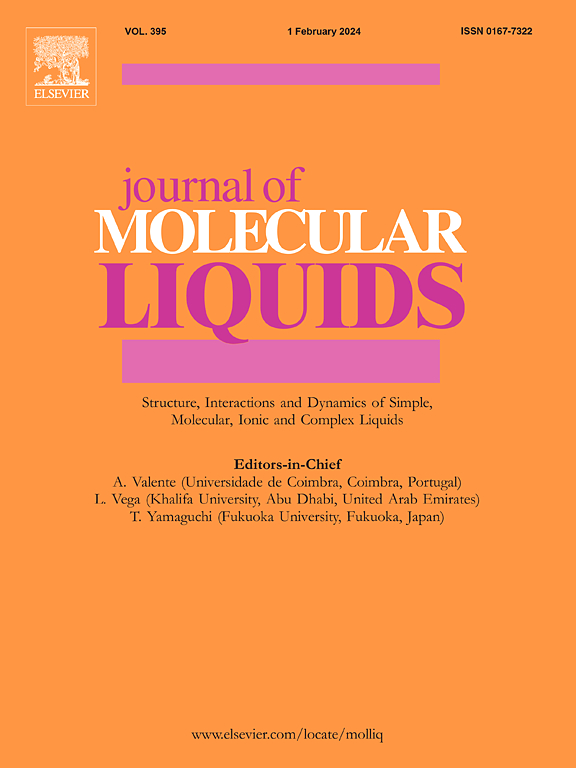通过反离子组成和链长设计具有巨大离子电导率的功能紫盐:极限在哪里?
IF 5.3
2区 化学
Q2 CHEMISTRY, PHYSICAL
引用次数: 0
摘要
我们报道了五种新的双离子液体(DCIL)盐的合成,表征和电导率响应,这些盐具有苯基延伸的紫红色核偶联两种不同长度(n = 3和7)的末端氧基(CH2CH2O)n,并与三种不同的反阴离子配对:氟磺酰亚胺(n (FSO2)2−,FSI),三氟甲基磺酰亚胺(n (CF3SO2)2−,TFSI)和非氟磺酸盐(CF3(CF2)3SO3−,ONf)。由于(CH2CH2O)n链的塑化作用,所有的盐都是无定形的,并表现出接近或低于零的玻璃化转变温度(Tgs),并且在有机溶剂中表现出发色团反应。这五种盐表现出较大的介电响应,电导率在10-0.5 S·cm−1范围内,这是由较小的反阴离子FSI促进的。这些电导率值对于有机(非水)介质是实质性的,可与基准商业电解质相媲美,将这些紫盐定位为文献中报道的性能最高的离子液体之一。本文章由计算机程序翻译,如有差异,请以英文原文为准。

Designing functional viologen salts with colossal ionic conductivities through counterion composition and chain length: where is the limit?
We report the synthesis, characterization, and conductivity response of five new dicationic ionic liquid (DCIL) salts featuring phenyl-extended viologen cores coupled with terminal oxyethylene groups (CH2CH2O)n of two different lengths (n = 3 and 7) and paired with three distinct counter-anions: fluorosulfonylimide ((N(FSO2)2−, FSI), trifluoromethylsulfonylimide (N(CF3SO2)2−, TFSI), and nonaflate (CF3(CF2)3SO3−, ONf). All salts are amorphous and exhibit near- or sub-zero glass transition temperatures (Tgs), attributed to the plasticizing effect of the (CH2CH2O)n chains, and show chromophore responses in organic solvents. The five salts display large dielectric responses with conductivities in the 10–0.5 S·cm−1 range, facilitated by the smaller counter-anion, FSI. These conductivity values are substantial for organic (non-aqueous) media, comparable to benchmark commercial electrolytes, positioning these viologen salts among the highest-performing ionic liquids reported in the literature.
求助全文
通过发布文献求助,成功后即可免费获取论文全文。
去求助
来源期刊

Journal of Molecular Liquids
化学-物理:原子、分子和化学物理
CiteScore
10.30
自引率
16.70%
发文量
2597
审稿时长
78 days
期刊介绍:
The journal includes papers in the following areas:
– Simple organic liquids and mixtures
– Ionic liquids
– Surfactant solutions (including micelles and vesicles) and liquid interfaces
– Colloidal solutions and nanoparticles
– Thermotropic and lyotropic liquid crystals
– Ferrofluids
– Water, aqueous solutions and other hydrogen-bonded liquids
– Lubricants, polymer solutions and melts
– Molten metals and salts
– Phase transitions and critical phenomena in liquids and confined fluids
– Self assembly in complex liquids.– Biomolecules in solution
The emphasis is on the molecular (or microscopic) understanding of particular liquids or liquid systems, especially concerning structure, dynamics and intermolecular forces. The experimental techniques used may include:
– Conventional spectroscopy (mid-IR and far-IR, Raman, NMR, etc.)
– Non-linear optics and time resolved spectroscopy (psec, fsec, asec, ISRS, etc.)
– Light scattering (Rayleigh, Brillouin, PCS, etc.)
– Dielectric relaxation
– X-ray and neutron scattering and diffraction.
Experimental studies, computer simulations (MD or MC) and analytical theory will be considered for publication; papers just reporting experimental results that do not contribute to the understanding of the fundamentals of molecular and ionic liquids will not be accepted. Only papers of a non-routine nature and advancing the field will be considered for publication.
 求助内容:
求助内容: 应助结果提醒方式:
应助结果提醒方式:


